Students can access the CBSE Sample Papers for Class 12 Chemistry with Solutions and marking scheme Set 5 will help students in understanding the difficulty level of the exam.
CBSE Sample Papers for Class 12 Chemistry Set 5 with Solutions
Time Allowed: 3 hours
Maximum Marks: 70
General Instructions:
- There are 33 questions in this question paper with internal choice
- SECTION A consists of 16 multiple-choice questions carrying 1 mark each.
- SECTION A consists of 16 multiple-choice questions carrying 1 mark each.
- SECTION C consists of 7 short answer questions carrying 3 marks each.
- SECTION D consists of 2 case-based questions carrying 4 marks each.
- SECTION E consists of 3 long answer questions carrying 5 marks each.
- All questions are compulsory.
- Use of log tables and calculators is not allowed.
SECTION – A (16 Marks)
The following questions are multiple-choice questions with one correct answer. Each question carries 1 mark. There is no internal choice in this section.
Question 1.
If the concentration is expressed in moles per litre the unit of the rate constant for a first order reaction is:
(a) mole litre-1 sec-1
(b) mole litre-1
(c) sec-1
(d) mole-1
Answer:
(c) sec-1
Explanation: For first order,
n = 1
K = (mol)1-n Ln-1 s-1
So, K = (mol)1-1 L1-1 s-1
K = s-1
Question 2.
Baeyer’s reagent is which of the following?
(a) Acidified KMnO4
(b) Aqueous KMnO4
(c) Acidified K2Cr2O7
(d) Alkaline KMnO4
Answer:
(d) Alkaline KMnO4
Explanation: Baeyer’s reagent is an alkaline KMnO4 solution. This shows a redox reaction because Baeyer’s reagent is an alkaline solution of cold potassium permanganate, which is a potent oxidant. The colour of an organic material fades from purplish-pink to brown as it reacts with double or triple bonds.
![]()
Question 3.
Match the Columns:
| Column I | Column II |
| 1. Dry cell | (p) Potassium hydroxide |
| 2. Nickel-cadmium cell | (q) Aqueous H2SO4 |
| 3. Lead storage cell | (r) Zinc chloride |
(a) l-(r), 2-(p), 3-(q)
(b) l-(q),2-(r),3-(p)
(c) l-(p), 2-(r), 3-(q)
(d) l-(p), 2-(q), 3-(r)
Answer:
(a) l-(r), 2-(p), 3-(q)
Explanation: The electrolyte used in dry cell, nickel-cadmium cell and leads storage cell is zinc chloride, potassium hydroxide and aqueous H2SO4 respectively.
Question 4.
Optical rotations of some compounds along with their structures are given below which of them have D configuration.

Answer:
(a) I, II, III
(b) II, III
(c) I, II
(d) III
Answer:
(a) 1,11,111
Explanation: D-configuration of the compounds is always compared to the structure of (+) glycerides. Among the given options I, II, and III shows D-configuration with -OH group on the right side of asymmetric carbon.
Question 5.
In a plot of log K vs. 1/T, the slope is:

Answer:
Explanation: Rate constant of any reaction is given by the formula,

![]()
Question 6.
The product formed when aniline is warmed with chloroform and alcoholic KOH is:
(a) Phenyl chloride
(b) Methyl isocyanide
(c) Phenyl isocyanide
(d) Nitrophenol
Answer:
(c) Phenyl isocyanide
Explanation: When aniline reacts with chloroform and alcoholic KOH it gives an offensive smelling liquid i.e., phenyl isocyanide as product. It is called as isocyanide test. It is given by aliphatic and aromatic primary amines.

Question 7.
On oxidation with a mild oxidising agent like Br2/H2O, the glucose is oxidized to:
(a) Saccharic acid
(b) Glucaric acid
(c) Gluconic acid
(d) Valeric acid
Answer:
(c) Gluconic acid
Explanation: On oxidation with a mild oxidising agent like Br2/H2O, the glucose is oxidised to six carbon carboxylic acid (gluconic acid). This indicates that the carbonyl group is present as an aldehydic group.

Question 8.
In the reaction of phenol with CHC13 and aqueous NaOH at 70°C, the electrophile attacking the ring is:
(a) CHCl3
(b) CCl2
(c) CHCl2
(d) COCl2
Answer:
(c) CHCl2
Explanation: In the reaction of phenol with CHCl3 and aqueous NaOH at 70°C, the electrophile attacking the ring is CCl2. This is known as Reimer Tiemann Reaction. Reimer Tiemann Reaction makes ortho substituted phenol:
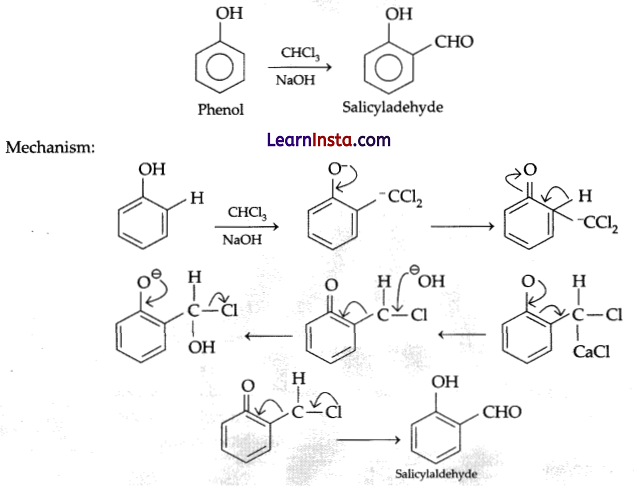
Question 9.
Ethanol on heating with cone. H2SO4 at 443 K gives:
(a) Diethyl sulphate
(b) Ethylene, C2H4
(c) Diethyl ether, (C2H5)2O
(d) Ethyl hydrogen sulphate, C2H5HSO4
Answer:
(b) Ethylene, C2H4
Explanation: When ethanol is heated with cone. H2SO4 at 443K, the product obtained is ethylene.

![]()
Question 10.
The rate of a chemical reaction doubles for every 10°C rise of temperature. If the temperature is raised by 50°C, the rate of the reaction increases by about:
(a) 10 times
(b) 24 times
(c) 32 times
(d) 64 times
Answer:
(b) 32 times
Explanation: Forevery10°C rise of temperature, the rate is doubled. Thus, the temperature coefficient of the reaction = 2
When temperature is increased by 50°C, rate becomes
= 2(50/100) = 25 times = 32 times
Question 11.
The standard emf of a galvanic cell involving cell reaction with n = 2 is formed to be 0.295 V at 25° C. The equilibrium constant of the reaction would be:
(a) 1.0 × 1010
(b) 2.0 × 1012
(c) 4.0 × 1011
(d) 1.0 × 102
[Given F = 96500 (mol-1), R = 8, 314JK-1 mol-1]
Answer:
(a) 1.0 × 1010
Explanation: For a cell reaction in equilibrium at 298K.

log Kc = 10
⇒ log Kc = 1 × 1010.
Question 12.
The relative order of esterification of alcohol is:
(a) 1° < 2° < 3°
(b) 1° > 2° > 3°
(c) 1° > 3° > 2°
(d) 1° < 3° < 2°
Answer:
(b) 1° > 2° > 3°
Explanation: Esterification is the process in which an organic acid (RCOOH) combines with an alcohol (ROH) to form a fruity smell product ester (RCOOR) and water. The relative order of esterification of alcohols is 1° > 2° > 3°. This is because as the steric hinderance (or bulkiness) increases from primary to secondary to tertiary alcohol, the removal of H+ will be difficult, hence, the order of esterification decreases.
Question No.13 to 16 consist of two statements-Assertion (A) and Reason (R). Answer these questions selecting the appropriate option given below:
(a) Both A and R are true and R is the correct explanation of A.
(b) Both A and R are true but R is not the correct explanation of A.
(c) A is true, but R is false.
(d) A is false, but R is true
Question 13.
Assertion (A): Molecular mass of KCl calculated on the basis of colligative properties will be lower than the normal molecular mass.
Reason (R): Experimentally determined molar mass is always lower than the true value.
Answer:
(c) A is true, but R is false.
Explanation: KCl undergoes dissociation in solution, hence, observed molar mass will be lower. Experimentally, determined molar mass can be higher or lower depending upon whether solute undergoes dissociation or association. Hence, assertion is true but reason is false.
![]()
Question 14.
Assertion (A): The rate of reaction is the rate of change of concentration of a reactant or a product.
Reason (R): Rate of reaction remains constant during the complete reaction.
Answer:
(c) A is true, but R is false.
Explanation: Rate of reaction does not remain constant during the complete reaction because rate depends upon the concentration of reactants which decreases with time.
Question 15.
Assertion (A): Many trivalent lanthanoid ions are coloured both in solid state and in aqueous solution.
Reason (R): Colour of these ions is due to the presence of f-electrons.
Answer:
(a) Both A and R are true and R is the correct explanation of A.
Explanation: Many trivalent lanthanoid ions are coloured both in the solid state and in aqueous solutions and colour of these ions is due to the presence of f-electrons. Thus, both assertion and reason are correct statements and reason is the correct explanation of assertion.
Question 16.
Assertion (A): Tert-butyl alcohol undergoes acid catalysed dehydration readily than propanol.
Reason (R): 3° alcohols do not give Victor-Meyer’s test.
Answer:
(b) Both A and R are true and R is not the correct explanation of A.
Explanation: Alcohol which forms the more stable carbocation undergoes dehydration more readily. Since tert-butyl alcohol forms more stable tert-butyl cation, therefore, it undergoes dehydration most readily than propanol. Primary (1°) and secondary (2°) alcohols give Victor-Meyer’s test but not tertiary (3°) alcohol. Hence, both assertion and reason are correct but reason is not the correct explanation for assertion.
SECTION – B (10 Marks)
This section contains 5 questions with internal choice in one questions. The following questions are very short answer type and carry 2 marks each.
Question 17.
(a) A solution of water and methanol is which type of mixture?
(b) What is the role of common salt in de-icing?
Answer:
(a) A solution of water and methanol is minimum boiling azeotropic mixture.
(b) De-icing is a process of removal of snow, ice and frost from surfaces such as roads using de-icing agents. De-icing agents such as common salt decreases the freezing point of ice and eventually melts the ice deposited and clears the surface.
OR
30 g of urea (M = 60 g mol-1) is dissolved in 846 g of water. Calculate the vapour pressure of water for this solution if vapour pressure of pure water at 298 K is 23.8 mm Hg.
Answer:
WB = 30g
WA = 846 g
P° = 23.8 mmHg
Ps = x
MB = 60 g mol-1
MA = 18 g mol-1
Relative lowering of vapour pressure

23.8 – x = 0.253
x = 23.8 – 0.253 = 23.547
So, vapour pressure of water for this solution = 23.547 mmHg.
![]()
Question 18.
(a) Which would undergo SN1 reaction faster in the following pair:

(b) What is the effect of branching on the boiling point of isomeric haloalkanes?
Answer:
(a)
 will undergo SN1 reaction faster due to stable carbocation (3°carbocation).
will undergo SN1 reaction faster due to stable carbocation (3°carbocation).
(b) Boiling point decreases with increasing branching.
Question 19.
Despite having an aldehyde group, glucose does not give 2, 4-DNP test. What does this indicate? What is the significance of D and (+) here?
Answer:
Glucose does not have open chain structure and hence it does not have a free —CHO group. Actually —CHO group combines with C5 —OH to form a hemiacetal.
Glucose largely exists in the cyclic hemiacetal form along with a very small amount (0.5%) of the open chain form. Since the concentration of the open chain form is low and its reaction with 2, 4-DNP is reversible, therefore, formation of 2, 4-DNP derivative cannot disturb the equilibrium to generate more of the open chain form from the cyclic hemiacetal form and hence, it does not react with 2, 4-DNP.
The capital letter D in the name D-(+)- glucopyranose indicates that the C5 —OH group is oriented towards right while the sign (+) indicates that glucopyranose is dextrorotatory.
Question 20.
How would you convert the following:
(a) Phenol to benzoquinone.
(b) Ethanol to 2—Propanol
Answer:

Question 21.
(a) (CH3)2 NH is more basic than (CH3)3 N in an aqueous solution. Explain.
(b) How will you differentiate between aniline and ethylamine?
Answer:
(a) In aqueous solution 2° amine is more basic than 3° amine due to the combined effect of the inductive effect, solvation effect and steric factor.
(b) As anilineis an aromatic primary amine on with HNO2 at 0°-5°C followed by treatment with an alkaline salution of β-naphthol gives an orange coloured azo dye. But ethylamine does not give this test.
![]()
SECTION – C (21 Marks)
This section contains 7 questions with internal choice in one questions. The following questions are short answer type and carry 3 marks each.
Question 22.
Attempt any two.
(a) What are essential and non-essential amino acids? Give two examples of each.
(b) How are nucleosides different from nucleotides?
(c) Give one example each of globular protein and fibrous protein.
Answer:
(a) Non-essential amino acids: The amino acids which can be synthesised in the body, are known as non-essential amino acids. For example, Glycine, Alanine, etc.
Essential amino acids: The amino acids which cannot be synthesised in the body and must be obtained through diet are known as essential amino acids. For example, Valine, Leucine, etc.
(b) Nucleoside: A nucleoside contains only two basic components of nucleic acids i.e., a pentose sugar and a nitrogenous base. During their formation 1-position of the pyrimidine or 9-position of the purine moitey is linked to C1 of the sugar (ribose or deoxyribose) by a β-Iinkage.

Nucleotides: A nucleotide contains all the three basic components of nucleic acids, i.e., a phosphoric acid group, a pentose sugar and nitrogenous base. These are formed by esterification of C5‘ —OH of the sugar of the nucleoside with phosphoric acid.
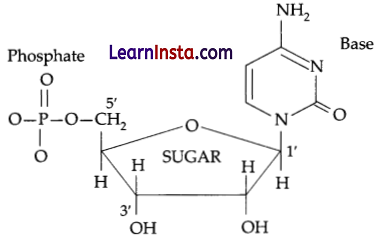
(c) Globular protein: All enzymes and hormones like insulin.
Fibrous protein: Keratin in skin, nails, etc.
Question 23.
An organic compound (A) having molecular formula C4H8O gives orange red precipitate with 2, 4-DNP reagent. It does not reduce Tollens’ reagent but gives yellow precipitate of iodoform on heating with NaOH and I2. Compound (A) on reduction with NaBH4 gives compound (B) which undergoes dehydration reaction on heating with cone. H2SO4 to form compound (C). Compound (C) on Ozonolysis gives two molecules of ethanal.
Identify (A), (B) and (C) and write their structures. Write the reactions of compound (A) with (a) NaOH/I2 and (b) NaBH4.
Answer:
C4H8O (A) gives precipitate with 2, 4-DNP, it indicates that compound A contains a carbonyl group. It does not reduce Tollen’s reagent so it is a ketone compound. It gives Iodoform test as it contains a methyl ketone group (-COCH3). Let us assume tentative structure of A as X—COCH3. Now, A gives compound B on NaBH4 reduction, so the structure of compound B becomes X-CHOH-CH3. Compound B further is subjected to dehydration which means the new compound C will contain a double bond. Compound C gives two molecules of ethanal on Ozonolysis, this tells us that compound C is symmetrical and the double bond divides the molecule in two equal parts.
Collecting all the above given information, the reaction sequence can be formulated as:
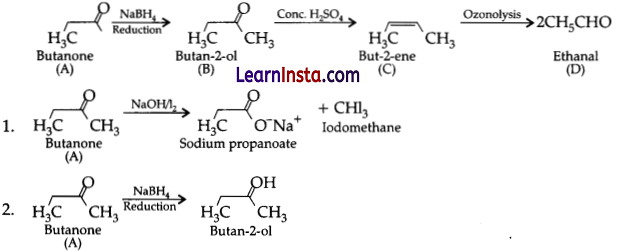
![]()
Question 24.
What happens when:
(a) Acetamide is treated with Br2 and NaOH.
(b) Aniline is treated with bromine water.
(c) Ethylamine is heated with chloroform and alcoholic potassium hydroxide.
Answer:
(a) Acetamide (CH3CONH2) undergoes Hoffmann Bromamide degradation in presence of bromine and NaOH to give Methanamine.
CH3CONH2 + Br2 + 4NaOH → CH3NH2 + Na2CO3 + 2NaBr + 2H2O
(b) Aniline reacts with bromine water at room temperature to give 2, 4, 6-tribromoaniline and hydrobromic add.

(c) Ethylamine being a primary amine forms foul-smelling methyl isocyanide on heating with chloroform and alcoholic potassium hydroxide:

Question 25.
Calculate the weight of glucose which when dissolved in 100 g of water will cause lowering of vapour pressure by 0.23 mm of Hg. Vapour pressure of pure water is 54.2 mm of Hg.
Answer:
The given information is:
P1 (vapour pressure of solvent) = 54.2 mm Hg; Molecular weight of glucose (C6H12O6), M2 = 180 g mol-1;
Lowering of vapour pressure (i.e., P1 – p1) = 0.23 mm Hg; M1 = 18 g; w1 = 100 g.
Relative lowering of vapour pressure can be given by the below formula:
P1 – p1/P1 = w2 × M1/M2 × w1
Here, P1 and p1 are vapour pressure of solvent and solution respectively, w1 and w2 are masses and M1 and M2 are molar masses of the solute and solvent respectively.
Now, putting the values in equation:
0.23 mm Hg/54.2 mm Hg = w2 × 18 g mol-1/180 g mol-1 × 100 g
w2 = 4.24 g
Hence, weight of glucose is 4.24 g.
Question 26.
(a) What is the unit of specific conductance?
(b) Define the term electrochemical equivalent of an element.
(c) Name an instrument which can be used to determine electrochemical equivalent of an element.
Answer:
(a) Unit of specific conductance is S m-1.
(b) Electrochemical equivalent (ECE) of a substance is the amount of a substance in grams produced or consumed by the passage of one coulomb of electricity in an electrochemical reaction.
(c) A voltmeter is used to measure the electrochemical equivalent of an element.
Question 27.
p-Nitrobenzoic add is a stronger add than p-Chlorobenzoic acid due to its better electron withdrawing effect. Though chlorine atom withdraws electron due to its – I effect but at the same time takes part in resonance with the phenyl group through its lone pair of electrons making it less addic than p-Nitrobenzoic acid.
Consider the following data for the reaction :
A + B → Product
| Experiment Number | [A] mol L-1 | [B] mol L-1 | [Rate] mol sec-1 |
| 1 | 0.10 M | 1.0 | 2.1 × 10-3 |
| 2 | 0.20 M | 2.0 | 8.4 × 10-3 |
| 3 | 0.30 M | 3.0 | 8.4 × 10-3 |
Determine the order of reaction with respect to A and with respect to B and the overall order of reaction.
Answer:
The rate of law may be expressed as
Rate = k[A]p[B]q
Comparing experiments 2 and 3
(Rate)2 = k[0.2]p [1.0]q = 8.4 × 10-3 … (i)
(Rate)3 = k[0.2]p [2.0]q = 8.4 × 10-3 … (ii)
Dividing equation by (ii) by (i)
\(\frac{(\text { Rate })_3}{(\text { Rate })_2}=\frac{k[0.2]^p[2.0]^q}{k[0.2]^p[1.0]^q}=\frac{8.4 \times 10^{-3}}{8.4 \times 10^{-3}}\)
[2]q = [2]° or q = 0
Comparing experiments (i) and (ii)
(Rate)2 = k[0.2]p [1.0]q = 8.4 × 10-3 … (iii)
(Rate)1 = k[0.10]p [1.0]q = 2.1 × 10-3 … (iv)
Dividing equation, (iii) by (iv)
\(\frac{(\text { Rate })_2}{(\text { Rate })_1}=\frac{k[0.20]^p[1.0]^q}{k[0.10]^p[1.0]^q}=\frac{8.4 \times 10^{-3}}{2.7 \times 10^{-3}}=4\)
[2]q = [2]2 or q =2
order with respect to A = 2
order with respect to B = 0
![]()
Question 28.
Answer the following questions:
(a) On the basis of crystal field theory, write the electronic configuration of d4 ion if Δ0 < p.
(b) Write the hybridization and the magnetic behaviour of the complex [Ni(CO)4]. (At no. of N = 28).
Answer:
(a) For ns° (n-1)d4 configuration i.e., the crystal field splitting energy is less than pairing energy, shows that the ligand must be a weak field ligand. Hence the 4th electron will go to eg level rather than pairing in t2g level. So configuration will be t2g 3 eg1.
(b) In [Ni(CO)4] here Ni has oxidation number 0, i.e., 3d84s2 state. Also CO is a strong field ligand.

Inner orbital complex, diamagnetic and tetrahedral shape.
SECTION – D (8 Marks)
The following questions are case-based questions. Each question has an internal choice and carries 4 (1+1+2) marks each. Read the passage carefully and answer the questions that follow.
Question 29.
The SN2 reaction mechanism involves the nucleophilic substitution reaction of the leaving group (which generally consists of halide groups or other electron-withdrawing groups) with a nucleophile in a given organic compound. The rate-determining step of this reaction depends on the interaction between the two species, namely the nucleophile and the organic compound. The SN2 reaction is a good example of stereo specific reaction, one in which different stereoisomers react to give different stereoisomers of the product. Also, SN2 reaction is the most common example of Walden inversion where an asymmetric carbon atom undergoes inversion of configuration.
SN2 reaction were carried out for different haloalkanes and different results were obtained for them as tabulated below

(a) During SN2 reaction which type of configuration takes place?
(b) Why (CH3)3CCH2Cl does not undergo SN2 reaction?
(c) Why  does not undergo SN2 reaction?
does not undergo SN2 reaction?
OR
Why CH3CH2—Cl can easily undergo SN2 reaction?
Answer:
(a) As during SN2 reaction back-side approach of the nucleophile takes place, thus inversion of configuration occurs.
(b) Neopentyl halide having three alkyl groups at the β-carbon and thus, due to steric hindrance it does not undergo SN2 reaction.
(c)  is a tertiary substrate and also the back side attack on a-carbon is not at all possible because of its cage like structure. So, it does not undergo SN2 reaction.
is a tertiary substrate and also the back side attack on a-carbon is not at all possible because of its cage like structure. So, it does not undergo SN2 reaction.
OR
CH3CH2Cl is a primary substrate and back side approach of the nucleophile is more feasible and easy. Hence SN2 reaction occur here.
![]()
Question 30.
Coordination compound is any of a class ofsubstances with chemical structures in which a central metal atom is surrounded by non-metal atoms or groups of atoms, called ligands, joined to it by chemical bonds. oordination compounds include such substances as vitamin B12, haemoglobin, and chlorophyll, dyes and pigments, and catalysts used in preparing organic substances. A major application of coordination compounds is their use as catalysts, which serve to alter the rate of chemical reactions.
In [Fe(CN)6]4- and [Fe(H2O)6]2+, Fe is in +2 oxidation state. It is observed that dilute solutions of these complex give different colour as given in the table below:
| Metal complex | Colour |
| Dilute solution of [Fe(CN)6]4- | Light green |
| Dilute solution of [Fe(H2O)6]2+ | Pale yellow |
Answer the following questions:
(a) What is the reason for different colour ?
(b) [Fe(CN)6]4- is a spin-paired on spin free complex?
(c) Explain briefly why dilute solution of [Fe(CN)6]4- gives light green colour?
OR
Explain why [Fe(H2O)6]2+ is pale yellow using crystal field splitting?
Answer:
(a) The different colours are due to the different mode of d-d electron transition.
(b) [Fe(CN)6]4- is a spin paired complex as there is no unpaired electron in the t2g level because of the strong field CNΘligand.
(c)

SECTION – E (15 Marks)
The following questions are long answer type and carry 5 marks each. All questions have an internal choice.
Question 31.
Attempt any five of the following:
Give reasons :
(a) Transition metals form large number of complex compounds.
(b) The lowest oxide of transition metal is basic whereas the highest oxide is amphoteric or acidic.
(c) E° value for the Mn3+/Mn2+ couple is highly positive (+ 1.57 V) as compare to Cr3+/Cr2+.
(d) Transition metals and many of their compounds show paramagnetic behaviour.
(e) The enthalpies of atomisation of the transition metals are high.
(f) The transition metals generally form coloured compounds.
(g) Transition metals and their many compounds act as good catalyst.
Answer:
(a) Transition metals forms large number of complexes due to:
1. Small size of atoms and ions of transition metals.
2. High nuclear charge.
3. Presence of incompletely filled d-orbitals.
(b) As the oxidation state increases, the size of ion goes on decreasing thus the covalent character increases as a result of this amphoteric and acidic strength increases. While in case of lower oxides of transition metals ionic size increases and thus basic character increases.
(c) This is because Mn2+ has 3d5 as a stable oxidation state which is half filled and stable. Mn has very high third ionisation energy for change from d5 to d4 but in case of Cr3+, 3d3 is more stable due to t32g (crystal field splitting theory) that is why Mn3+/Mn2+ is highly positive as compared to Cr3+/Cr2+.
(d) Transition metals show paramagnetic behaviour due to the presence of unpaired electrons in the d-orbitals. Each electron having a magnetic moment associated with its spin angular momentum. However, in the first transition series, the orbital angular momentum is quenched. Therefore, the resulting paramagnetism is only because of the unpaired electron.
(e) Transition elements have large number of d-subshell valence electrons. Therefore, they form very strong metallic bonds. As a result, the enthalpy of atomisation of transition metals is high.
(f) Most of the complexes of transition metals are coloured. This is because of the absorption of radiation from visible light region to promote an electron from one of the d-orbitals to another that is d-d transition. In the presence of ligands, the d-orbitals split up into two sets of orbitals having different energies. Therefore, the transition of electrons can take place from one set to another. The energy required for these transitions is quite small and falls in the visible region of radiation. Hence reflected radiation is visible in the form of coloured solutions.
![]()
(g) The catalytic activity of the transition elements can be explained by two basic facts:
1. Because of their ability to show variable oxidation states and form complexes, transition metals form unstable intermediate compounds. Thus, they provide a new path with lower activation energy, Ea, for the reaction to proceed.
2. Transition metals also provide a suitable surface for the reactions to occur, i.e., act as a solid adsorption medium.
Question 32.
(a) Acellis prepared by dipping a zinc rod in 1M zinc sulphate solution and a silver electrode in 1M silver nitrate solution. The standard electrode potential given:
\(\mathrm{E}_{\mathrm{Zn}^{2+} / \mathrm{Zn}}^{\circ}=-0.76 \mathrm{~V}, \mathrm{E}_{\mathrm{Ag}^{+} / \mathrm{Ag}^{\circ}}^{\circ}=+0.80 \mathrm{~V}\)
What is the effect of increase in concentration of Zn2+ on the Ecell?
(b) Write the products of electrolysis of aqueous solution of NaCl with platinum electrodes.
(c) Calculate e.m.f. of the following cell at 298 K :
Ni(s)| Ni2+ (0.01 M) || Cu2+ (0.1M)| Cu(s)
[Given \(\mathrm{E}_{\mathrm{Ni}^{2+} / \mathrm{Ni}}^{\circ}=-0.25 \mathrm{~V}, \mathrm{E}_{\mathrm{Cu}^{2+} / \mathrm{Cu}}^{\circ}=+0.34 \mathrm{~V}\)]
Write the overall cell reaction
OR
(a) Apply Kohlrausch law of independent migration of ions, write the expression to determine the limiting molar conductivity of calcium chloride
(b) Given are the conductivity and molar conductivity of NaCl solutions at 295 K at different concentrations:
| S. No. | Concentration [M] | Conductivity [Scm-1] | Molar conductivity [S cm2 mol-1] |
| 1. | 0.100 | 106.74 x 10-4 | 106.7 |
| 2. | 0.05 | 55.53 x 10-4 | 111.1 |
| 3. | 0.02 | 23.15 x 10-4 | 115.8 |
Compare the variation of conductivity and molar conductivity of NaCl solutions on dilution. Give reason.
(c) 0.1 M KCl solution offered resistance of 100 ohms in a conductivity cell at 298 K. If the cell constant of the cell is 1.2 cm-1, calculate the molar conductivity of KCl solution.
Answer:
(a) Chemical equation for the given cell can be represented as :
Zn(s) + 2Ag+(aq) → Zn2+ + 2Ag(s)
And the Nemst equation can be written as:

So, the overall cell reaction is:
Ni(s) + Cu2+(aq) → Ni2+ + Cu(s)
Now emf of the cell could be given by:
E° = 0.33 V – (0.31 V) = 0.64 V
![]()
OR
(a) Kohlrausch law of independent migration of ions states that limiting molar conductivity of an electrolyte can be represented as the sum of the individual contributions of the anion and cation of the electrolyte. Thus if λ°Ca2+ and λ°Cl– are limiting molar conductivity of the calcium and chloride ions respectively, then the limiting molar conductivity for calcium chloride is given by the equation:
λ°m(Cacl2) = λCa2+ + 2λCl–
(b) Conductivity always decreases with the dilution, so as the case with given NaCl solution here, This can be explained by the fact that the number of ions per unit volume that carry the current in a solution decreases on dilution.
Molar conductivity of a solution at a given concentration is the conductance of the volume V of the solution containing one mole of electrolyte in a standard volume increases with decrease in concentration, same is the case here with NaCl solution. This is because the total volume, V, of solution containing one mole of electrolyte also increases.
(c) Molar conductivity= Lm = k/c
Where k is conductivity of the solution.
Now, Cell constant = G* = Conductivity x resistance
or Conductivity = Cell constant/resistance
k = 1.29 cm-1 / 100 Ω
= 1.29 x 10-2 S cm-1
Molar conductivity = Λm = 1.29 x 10-2 S cm-1 x 1000 cm3 L-1 molarity-1
= 1.29 x 10-2 S cm-1 x 1000 cm3 L-1 / 0.1 mol L-1
= 1.29 S cm2 mol-1.
Question 33.
An add [A] C8H7O2Br on bromination in the presence of FeBr3 gives two isomers [B] and [C] of the formula C8H6O2Br2. Vigorous oxidation of [A], [B] and [C] gives acids [D], [E] and [F] respectively. The acid [D] C7H5O2Br is the strongest acid among all the isomers whereas [E] and [F] each has molecular formula of C7H4O2Br2. Give structure of [A] to [F] with justification.
OR
(a) Answer the following:
(i) What is Fehling’s solution?
(ii) To what oxidation state ethanal converts Fehling’s solution.
(b) Predict the products of the following reactions:
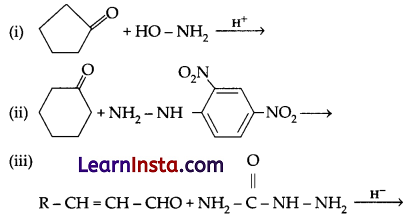
Answer:
From the formula C7H5O2Br seems like a carboxylic acid. Formation of two isomers [B] and [C] of formula C8H6O2Br2 must have given an ortho and para isomer.

Compound [A] can be any of these I, II or III structures.
As vigorous oxidation of [A] along with acid [B] and [C] produces strongest add [D] from structure [A] hence compound [A] must be structure [I].
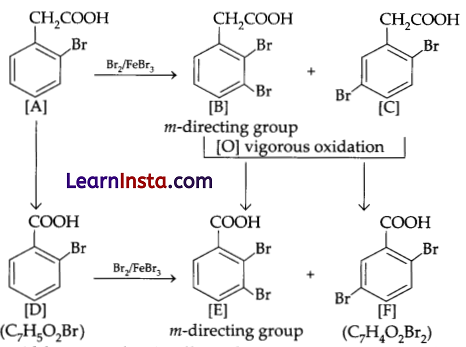
[D] is strongest add because of ortho-effect whereas presence of Br molecule at the meta position weakens the addic strength.
![]()
OR
(a) (i) Fehling’s solution is alkaline solution of CuS04 along with some Rochelle salt.
(ii) Ethanol converts Cu(II) of Fehling’s solution to Cu(I) i.e., +1 state.
